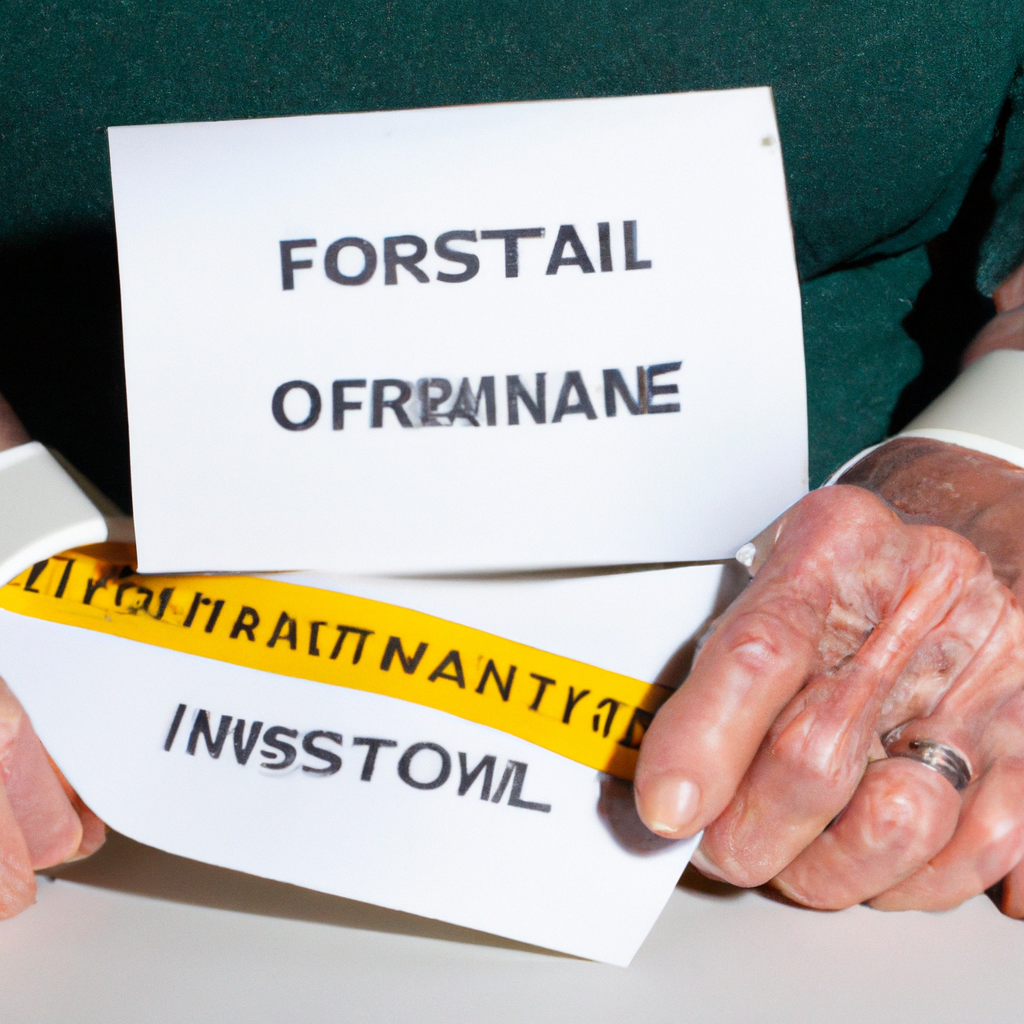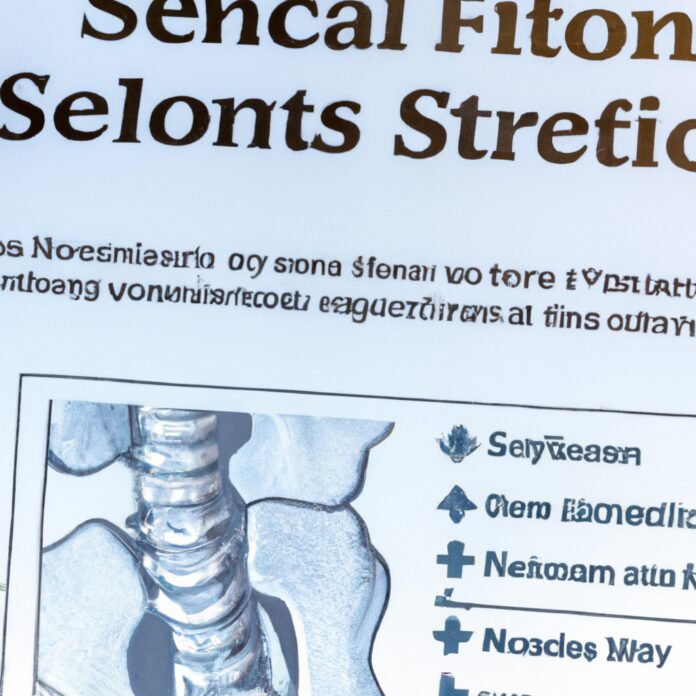As we age, our bones may become more fragile and prone to fractures, especially if we neglect our bone health. Osteoporosis, a common condition among seniors, can cause bones to become brittle and weak, leading to breaks or fractures that are difficult to recover from. However, maintaining bone health is not an impossible task, and even small lifestyle changes can make a big difference in preventing osteoporosis and fractures. In this article, we will explore some tips and strategies to help seniors maintain strong and healthy bones for a happier and healthier life.
1. The Importance of Bone Health for Seniors: Understanding Osteoporosis and Fractures
As we age, our bones become more fragile and susceptible to fractures. This is due to a condition called osteoporosis, which causes bones to become brittle and weak. According to the National Osteoporosis Foundation, over 53 million Americans have osteoporosis or are at risk of developing it. This makes it crucial for seniors to prioritize their bone health and take preventative measures to avoid fractures.
There are several risk factors that can contribute to the development of osteoporosis. These include age, gender, family history, low calcium or vitamin D intake, smoking, excessive alcohol consumption, and certain medical conditions such as hyperthyroidism and rheumatoid arthritis. By understanding these risk factors, seniors can take steps to reduce their likelihood of developing osteoporosis.
Some effective ways to promote bone health and prevent fractures include maintaining a healthy diet rich in calcium and vitamin D, participating in weight-bearing exercises like walking or weightlifting, and avoiding tobacco and excessive alcohol consumption. Additionally, supplements like calcium and vitamin D can also be helpful in maintaining bone density in those with a deficiency.
In conclusion, bone health is incredibly important for seniors looking to maintain their independence and quality of life. By taking preventative measures like eating a healthy diet and engaging in weight-bearing exercise, seniors can prevent osteoporosis and reduce their risk of fractures. It’s never too late to prioritize bone health, and taking action now can lead to a happier, healthier future.
2. Bone Up: Simple Steps for Preventing Osteoporosis in Later Life
Bone Health: Ways to Prevent Osteoporosis
As we age, our bones tend to weaken, and a condition that leads to brittle and fragile bones called osteoporosis can develop. Women after menopause are at greater risk of having this condition due to hormonal changes, while men’s risks increase after 70 years. However, men and women of all ages can take simple steps to ensure that their bones remain healthy and strong, preventing osteoporosis in later life.
One of the essential things to do is to ensure you’re eating a healthy diet rich in calcium and vitamin D. Calcium is needed to develop and maintain bones, while vitamin D helps your body absorb calcium. Eating foods such as milk, cheese, yogurt, dark leafy vegetables, and cereals help supply calcium while fatty fish, egg yolks, and fortified foods provide vitamin D.
Regular exercise can also help keep your bones strong and healthy. Weight-bearing exercises like running, dancing, walking, and strength training stimulate bone-forming cells, leading to stronger bones. Exercise also helps increase muscle strength, coordination, balance, and flexibility, reducing the risk of falls that can lead to fractures.
Avoiding smoking and drinking in moderation and reducing high salt and high caffeine intake can also help keep your bones healthy and strong. Maintaining a healthy weight and getting enough sleep each night is also critical in preventing osteoporosis. By following these simple steps, one can maintain good bone health and reduce the likelihood of developing osteoporosis later in life.
3. Nutrient-Rich Diets to Strengthen Aging Bones and Prevent Fractures
As we age, the risk of developing osteoporosis and fractures increases. However, eating a nutrient-rich diet can help improve bone health and reduce the risk of fractures. Here are some nutrient-rich foods that can strengthen aging bones:
- Calcium-rich foods: Calcium is essential for strong bones. Good sources of calcium include dairy products, leafy green vegetables, tofu, and fortified cereals.
- Vitamin D-rich foods: Vitamin D helps the body absorb calcium and maintain bone density. Good sources of vitamin D include fatty fish, egg yolks, and fortified foods.
- Protein-rich foods: Protein is important for maintaining muscle mass and bone strength. Good sources of protein include lean meats, poultry, fish, beans, and nuts.
In addition to these nutrient-rich foods, it’s important to limit alcohol and caffeine intake and avoid smoking. Excessive alcohol and caffeine consumption can cause bone loss, while smoking reduces bone density and increases the risk of fractures.
It’s also important to engage in weight-bearing exercises, such as walking, jogging, or weight lifting, to maintain bone density. Talk to your doctor or a certified personal trainer to develop an exercise regimen that’s appropriate for your fitness level and health needs.
Overall, a nutrient-rich diet and regular exercise can help strengthen aging bones and minimize the risk of fractures. By making these lifestyle changes, you can improve your quality of life and maintain your independence as you age.
4. Stay Active for Stronger Bones: Exercise Tips for Seniors
As we age, our bones tend to become weaker, which increases the risk of falls and fractures. However, regular exercise can help to preserve bone density and strength, allowing seniors to stay active and independent. Here are some exercise tips for seniors to keep their bones healthy:
- Strength Training: Resistance exercises such as weight lifting or resistance band workouts can stimulate bone growth and improve overall strength. Start with lighter weights or resistance and gradually increase as you become more comfortable.
- Weight-Bearing Activities: Activities such as walking, hiking, dancing, and climbing stairs put weight on the bones, which stimulates them to grow and maintain strength. Aim for at least 150 minutes of moderate-intensity activity each week.
- Balance Exercises: Improving balance can reduce the risk of falls and fractures in seniors. Try exercises such as standing on one leg or practicing tai chi.
- Flexibility Training: Stretching can improve range of motion and reduce the risk of injury. Try incorporating yoga or stretching exercises into your routine.
Remember to always consult with a physician before starting a new exercise routine. It’s important to start slowly and gradually increase the intensity and duration of your workouts. Stay active, keep moving, and your bones will thank you!
5. The Role of Technology in Monitoring Bone Health and Preventing Osteoporosis
Technology has revolutionized the way we monitor our bone health and prevent osteoporosis. With the advancement in medical devices and wearable technology, individuals can track their bone density and receive alerts when their bone health is deteriorating. Here are some ways technology is playing a vital role in preventing osteoporosis:
– Wearable sensors: Wearable sensors can track a patient’s physical activity and movement, which can help doctors assess the patient’s bone health and risk of fracture. These sensors can also help patients keep track of their exercise routine and provide feedback on their progress.
– 3D imaging: 3D imaging techniques can help measure bone density and structure. This technology can provide doctors with in-depth information about a patient’s bone health, which is essential for early detection and prevention of osteoporosis.
– Telemedicine: Telemedicine is another technology that is helping individuals receive medical advice and treatment from home. Patients can connect with their doctors through video calls and receive guidance on their bone health management. This approach can also help eliminate the need for in-person visits, which can be difficult for individuals with mobility issues.
– Mobile Apps: Mobile apps can help individuals track their bone health, provide reminders for medication, and offer helpful tips for maintaining healthy bones. These apps can also connect patients with support groups and connect them with practitioners who specialize in osteoporosis treatment.
In conclusion, technology is improving the way we monitor and prevent osteoporosis. From wearable sensors to 3D imaging and telemedicine, new technologies are making it easier for individuals to manage their bone health and prevent this disease. With these advancements, individuals can take control of their bone health and live a healthy and active life.
6. Are Supplements the Answer? Debunking Common Myths about Bone Health
Common Misconceptions About Bone Health Supplements
When it comes to our bones, most of us know that calcium is a crucial component and we need it to maintain healthy bone density. However, there are a number of myths that may mislead us and harm our bones instead of helping them. Here, we’ll be debunking a few of the most common myths associated with bone health supplements!
Myth #1: Calcium Supplements are Enough
Many people believe that taking a daily calcium supplement is the simplest and most effective way to meet their calcium needs. The truth is that since calcium is not the only important building block of healthy bones, taking a calcium supplement alone may not be effective in improving bone health. In reality, several other nutrients work in synergy to maintain strong bones.
Myth #2: Bone Health Supplements Are Only for the Elderly
While it’s true that our bones weaken as we age and we become more vulnerable to fractures, it doesn’t mean that young people should ignore bone health. We begin to lose bone mass in our mid-30s and it’s essential to properly nourish our bones throughout our lifetime. Besides, bone health supplements can also benefit athletes or individuals who have a sedentary lifestyle.
Myth #3: The More, The Better!
This is a dangerous misconception, particularly when it comes to calcium supplements. Too much calcium can cause artery calcification, leading to heart attacks and strokes. Instead, it’s essential to get the right balance of nutrients for your bone health needs. Besides, consuming excessively high doses of any nutrient will not necessarily result in better health outcomes.
In conclusion, the best way to maintain strong bones is to eat a well-balanced diet that includes various key nutrients and minerals, engage in physical activity, and receive adequate vitamin D from sunshine or supplements. While supplements may help fill any nutrient gaps, they should be used as a complement to a healthy diet, not a replacement.
7. Seeking Treatment: Identifying Warning Signs of Osteoporosis and Seeking Healthcare Support
Osteoporosis is a silent disease that weakens bones and puts people at risk for fractures. It is important to identify warning signs early and seek healthcare support. Here are some indicators that you may have osteoporosis:
- Back pain or a stooped posture
- Loss of height over time
- Frequent bone fractures (especially in the hip, spine, or wrist)
- Weak grip strength
- Difficulty standing or walking
If you experience any of these warning signs, it is essential to seek medical attention. A healthcare provider can perform a bone density test to diagnose osteoporosis and determine your risk for future fractures.
There are several treatment options for osteoporosis, including medications, lifestyle changes, and physical therapy. A healthcare provider can help determine the best course of action based on your specific needs.
Remember, early detection and treatment are essential in managing osteoporosis and preventing future fractures. Don’t hesitate to seek healthcare support if you think you may be at risk. Take care of your bones, and they will take care of you!
In conclusion, bone health is critical to maintaining overall physical health and mobility, particularly as we age. Preventing osteoporosis and fractures with the right lifestyle choices, exercise regimens, and proper nutrition is essential to keep the skeletal system function efficiently. While osteoporosis and fractures can be daunting, there is a myriad of steps seniors can take to maintain and improve their bone health. So stay active, eat well, and prioritize bone health; because healthy bones are the foundation for a healthy and happy life, regardless of your age.


